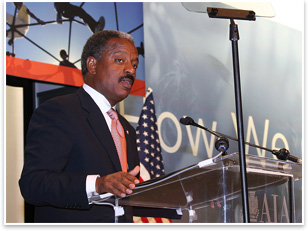
| The Three Most Powerful Words “We the People” sets the vision for the AIA national convention and beyond Ed. note: We bring you the opening speech of the 140th AIA national convention, May 15, 2008, in Boston, by AIA President Marshall E. Purnell, FAIA, in its entirety below. “We the People.” Four syllables, three words. Perhaps the three most powerful words after “Let there be light.” God’s word created the world. The words written by James Madison changed it.
Those words are magic! They escape the tyranny of their time. “We the People!” Breathe in the oxygen . . . the life-giving energy of these visionary words. Challenged by succeeding generations of the excluded and marginalized, the words have grown stronger . . . the meaning more profound . . . and the effect transformational. From every corner “It was we, the people; not we, the white male citizens; nor yet we, the male citizens; but we, the whole people, who formed the union . . . Men, their rights and nothing more; women, their rights and nothing less.” The spirit of “We the People” breathes through the text of the 14th Amendment, Section 1: “All persons born or naturalized in the United States, and subject to the jurisdiction thereof, are citizens of the United States and of the State wherein they reside.” “We the People.” The great 20th century theologian, Reinhold Niebuhr, believed that to achieve any kind of justice in an unjust world, the most vulnerable . . . the most vulnerable need to be empowered.
The healing genius of design . . . to reach into communities that have not been touched by the healing genius of design, communities that have lost hope, communities that lack the resources to articulate a vision for themselves and their children. What a gift, what a privilege to have the capacity to do so much and to have the skills to make a difference. The face of America
Praise be: This is the face of America. This is the face capturing the world’s imagination. This is a face rekindling a light, a spirit of hope hidden in the shadows far, far too long. As a profession, we’ve also made progress. You see it in the schools, where today women make up half the class. Nevertheless, in coming to grips with who we should be and who we should be serving, are we still confusing words for action? The people’s songs Not dignified, trivial, low class! Proper men and women listened to other nations’ songs. Yet the stone the builders rejected has become the cornerstone of the world’s song. The Middle East, China, Russia, Africa—we may not see eye-to-eye politically. But the feet of every nation are dancing to our music. The world’s children are humming America’s songs. Imagine the possibilities. Imagine a golden age of American architecture serving constituencies we have hardly touched! We the People. Not a few, not some, not even many, but all of us. The politics of possibility Hard but not impossible: The polemics of limits must be transcended through a politics of possibility. The work of this convention is to demonstrate that architects are essential . . . that our profession is a resource to address the most pressing issues of our time—where we live, where we work, how we come together, our place on the land, our place in the world, and how we leave it for the generations to come. The power of architecture on behalf of all people underlies every aspect of this convention. The program, both here and in the workshops and seminars, is designed to inspire . . . to inspire on many scales of interest, from the role of the architect in the world as a shaper of policy to the voice of people who might otherwise not be represented. To heal the split between what we say and what we do. All to come to grips with one thing, one thing that Martin Luther King described as life’s most persistent and urgent question: “What are we doing for others?”
|
||
Copyright 2008 The American Institute of Architects. All rights reserved. Home Page |
||
Quick Links
• Thursday’s plenary session summary
• Millard Fuller’s speech
Photos by Aaron Johnson
Innov8iv Design
idistudio.com

 Madison was not specific. He didn’t spell out who he had in mind. Was he able to escape his own times? Was he thinking that “We the people” included women? What about Native Americans, people without property? What about slaves?
Madison was not specific. He didn’t spell out who he had in mind. Was he able to escape his own times? Was he thinking that “We the people” included women? What about Native Americans, people without property? What about slaves?